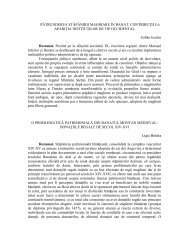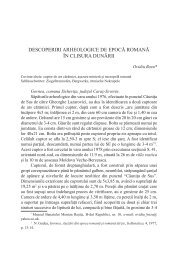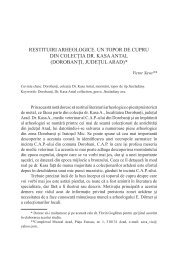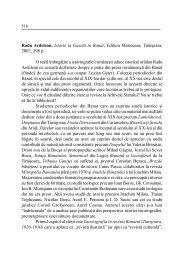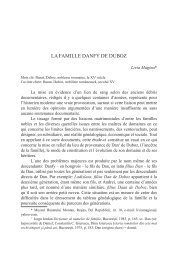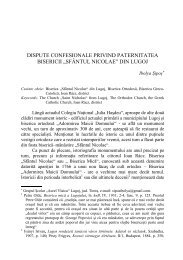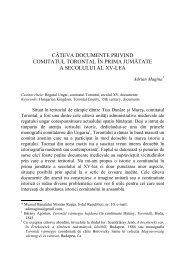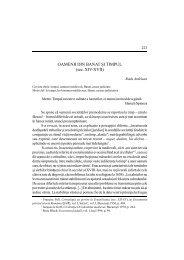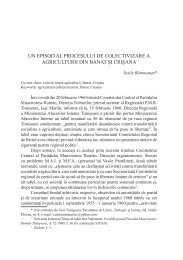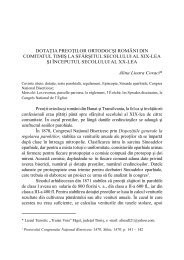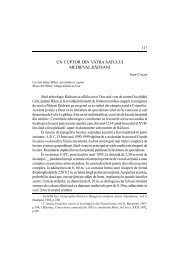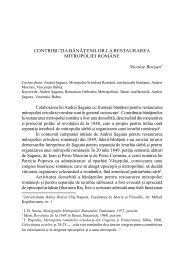Alexandru Simon - Banatica
Alexandru Simon - Banatica
Alexandru Simon - Banatica
You also want an ePaper? Increase the reach of your titles
YUMPU automatically turns print PDFs into web optimized ePapers that Google loves.
Turk had not been chased away from Graecia and even Europe. They had also<br />
provided the pope with Ottomans for Julius II’s Italian wars. According to<br />
Julius II, this was nothing new, and so Maximilian I kept on calling for a crusade.<br />
In fact, he wanted the Jubilee revenues, for an anti-Jagellonian action (Frederick<br />
III’s son was coming to terms with the fact that he could not defeat Venice).<br />
Maximilian I thus intiated talks with Bogdan in view of common action in the<br />
East. This prospect terrified Krakow (July 1510). Only a few months earlier, by<br />
Wladislaw II’s offices, the peace treaty between Sigismund and Bogdan III had<br />
been signed, putting an end to a conflict that had done no little damage to the<br />
whole of Christendom. King Sigismund was menaced also by Moscow, Bogdan<br />
III’s and Maximilian’s ally, the Tartars and the Teutonic Knights, Maximilian’s<br />
protégés. Wladislaw II had tried to come to Sigismund’s support by opening<br />
new negotiations with Istanbul and Venice (August-September). The<br />
development of the Ottoman dynastic conflict however changed the situation,<br />
giving more reasons to worry than to hope to Christian powers 8 .<br />
Aided by Tartars, Selim, at that time merely one of Bayezid’s rebellious<br />
sons had, gained control over the Crimean Peninsula, the Danube and the Dniestr<br />
Mounds, causing fear in Suceava, Buda and Krakow. In late 1510, the Walachian<br />
states were about to become Ottoman battlefields or, on the contrary, fiefs,<br />
namely Moldavia, for Selim I, in view of a settlement of the Ottoman conflict.<br />
oriental politics was played by Constantine Arianiti Comnen (Maximilian’s most beloved bloodrelative<br />
and captain-general in the future emperor’s own words of 1498), probably a close<br />
parent of Bogdan’s unnamed „Habsburg bride” of 1513 (Constantine was also related to the<br />
Branković, house of which Bogdan’s mother, Mary Voichiţa, the grand-niece of Mara Branković,<br />
Murad II’s wife, was a member; see also <strong>Simon</strong>, Lumea lui Djem, p. 17-20). For Constantine,<br />
see here Franz Babinger, Das Ende der Arianiten (=Sitzungsberichte der Bayerischen Akademie<br />
der Wissenschaften, NS, X, 4, Munich, 1960, p. 38 (note 2), 86 (note 4)<br />
8 Archivio di Stato di Venezia, Venice (ASVe), S.S., Deliberazioni, reg. 43, cc. 156 r -157 v (23 rd ,<br />
30 th of September 1509); HHStA, R.H.K., Maximiliana, fasc. 12-3, f. 144 r ; fasc. 15a-1, f. 29 r-v ;<br />
fasc. 15b-1, ff. 79 r -81 v ; fasc. 15b-3, ff. 4 r -14 r , 15 r -25 r , 51 r -58 v ; fasc. 15b-4, f. 58 r ; fasc. 17-2, ff. 6 r -<br />
11 r ; fasc. 19a-1, ff. 106 r -113 r (20 th of April 1508, 1 st of September 1509, 7 th of April, 25 th of June,<br />
5 th -8 th of August, 21 st of September 1510, 5 th of February, 15 th of April, 27 th of July 1511); Relazioni<br />
di ambasciatori veneti al Senato, XIX, Constantinopoli. Relazioni inedite (1512-1789), edited<br />
by Maria Pia Pedani-Fabris, Venice, 1996, p. 15; Acta Tomiciana, I, 1852, no. 74, p. 96; no. 83,<br />
p. 96; no. 232, p. 181; no. 242, p. 194; no. 301, p. 227; II, 1854, no. 218, p. 183; Hurmuzaki, II-<br />
2, no. 481, p. 613; supl. II-1, no. 1, p. 1-10; p. 15; Sanudo, IX, cols. 573-574; XII, 1 Marzo 1511-<br />
30 Settembre 1511, Venice, 1886, col. 508; XIV, 1 Marzo 1512-31 Agosto 1512, Venice, 1887,<br />
col. 50; [Giovanni Mari Angiolello] Donado da Lezze, Historia Turchesca, edited by I[oan].<br />
63



